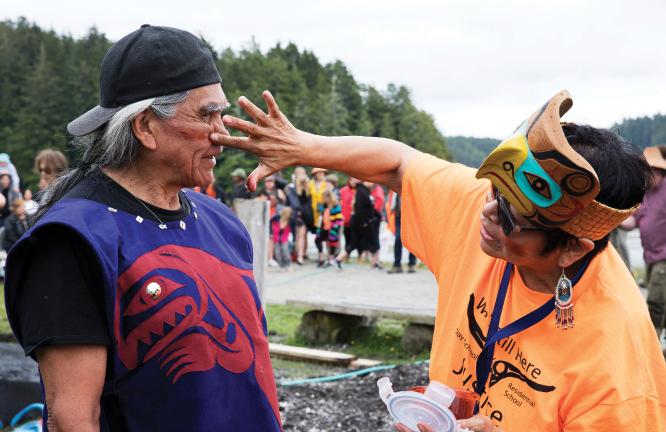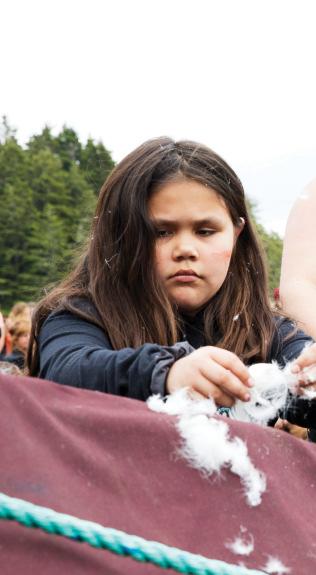
26 minute read
No plans to close West Coast General ER
Ha-Shilth-Sa newspaper is published by the Nuu-chah-nulth Tribal Council for distribution to the members of the NTC-member First Nations, as well as other interested groups and individuals. Information and original work contained in this newspaper is protected by copyright and may not be reproduced without written permission from:
Nuu-chah-nulth Tribal Council P.O. Box 1383, Port Alberni, B.C. V9Y 7M2. Telephone: (250) 724-5757 Fax: (250) 723-0463 Web page: www.hashilthsa.com facebook: Hashilthsa Ntc
Advertisement
2022 Subscription rates:
$35 per year in Canada and $40 per year in the U.S.A. and $45 per year in foreign countries. Payable to the Nuu-chah-nulth Tribal Council.
Manager/Editor/Reporter Eric Plummer (Ext. 243) (250) 724-5757 Fax: (250) 723-0463 eric.plummer@nuuchahnulth.org Reporter Denise Titian (Ext. 240) (250) 724-5757 Fax: (250) 723-0463 denise.titian@nuuchahnulth.org Reporter Melissa Renwick (416) 436-4277 Fax: (250) 723-0463 melissa.renwick@nuuchahnulth.org
Audio / Video Technician Mike Watts (Ext. 238) (250) 724-5757 Fax: (250) 723-0463 mike.watts@nuuchahnulth.org Editorial Assistant Holly Stocking (Ext. 302) (250) 724-5757 Fax: (250) 723-0463 holly.stocking@nuuchahnulth.org
DEADLINE:
Please note that the deadline for submissions for our next issue is
August 5, 2022 After that date, material submitted and judged appropriate cannot be guaranteed placement but, if material is still relevant, will be included in the following issue. In an ideal world, submissions would be typed rather than hand-written. Articles can be sent by e-mail to holly.stocking@nuuchahnulth.org (Windows PC). Submitted pictures must include a brief description of subject(s) and a return address. Pictures with no return address will remain on fi le. Allow two - four weeks for return. Photocopied or faxed photographs cannot be accepted.
COVERAGE:
Although we would like to be able to cover all stories and events, we will only do so subject to: - Suffi cient advance notice addressed specifi cally to Ha-Shilth-Sa. - Reporter availability at the time of the event. - Editorial space available in the paper. - Editorial deadlines being adhered to by contributors. Ha-Shilth-Sa will include letters received from its readers. Letters MUST be signed by the writer and have the writer’s full name, address and phone number on them. Names can be withheld by request. Anonymous submissions will not be accepted. We reserve the right to edit submitted material for clarity, brevity, grammar and good taste. We will defi nitely not publish letters dealing with tribal or personal disputes or issues that are critical of Nuu-chah-nulth individuals or groups. All opinions expressed in letters to the editor are purely those of the writer and will not necessarily coincide with the views or policies of the Nuu-chah-nulth Tribal Council or its member First Nations. Ha-Shilth-Sa includes paid advertising, but this does not imply Ha-Shilth-Sa or Nuu-chah-nulth Tribal Council recommends or endorses the content of the ads.
Photo by Karly Blats The Emergency Room at West Coast General Hospital is currently undergoing renovations to expand service to patients. No plans to close West Coast General ER
Port Alberni hospital emergency department averaged 52.8 visits per day last year
By Karly Blats Ha-Shilth-Sa Contributor
Port Alberni, BC - Despite a recent claim by a news outlet stating the Emergency Room at West Coast General Hospital (WCGH) may see closures this summer, Island Health says no shutdown is planned for the emergency department. According to a CBC article from July 5, an anonymous source who claimed to work in the Port Alberni emergency department at WCGH told the media outlet that due to ongoing staff shortages, the Emergency Room could be closed through much of August and September for eight-hour periods each day. “There are no planned closures or diversions for the emergency department at West Coast General Hospital,” Island Health said in a statement. “In general, diversion or temporary closure is a last resort and would only occur after every possible mitigation strategy is explored and exhausted. In all cases, it is a step taken to ensure the delivery of safe patient care.” Like all regions across Canada, Island Health is extremely challenged by the health workforce shortage. “Despite this, clinical leadership continues to work diligently to create and use mitigation strategies to balance staff ing across units and sites to ensure the continued provision of safe patient care,” said Island Health. “Island Health is actively working to ensure the availability of emergency services in the Alberni Valley region and beyond. We want to reassure the public that our hospitals and emergency departments are ready to take care of anyone who shows up in need of care.” In 2021/2022 fi scal year, the West Coast General Hospital emergency department averaged 52.8 visits per day. Mariah Charleson, Nuu-chah-nulth Tribal Council vice-president, is a member of the First Nations Health Council and said she hasn’t heard any news of the Emergency Room at WCGH closing. “Of course, the emergency department is very important to many Nuu-chahnulth, particularly some of our more vulnerable population, as they are often without a family physician, therefore the emergency department is the only option for treatment,” Charleson said. Construction is currently underway to expand the emergency department at WCGH to support improvements to patient care and privacy for people in the region. “West Coast General Hospital is an important part of the community for residents in the area, including Port Alberni, Tofi no, Ucluelet, Bamfi eld, Hupacasath and Tseshaht First Nations, Uchucklesaht Tribe, Huu-ay-aht and Ditidaht First Nations, Yuułuʔiłʔatḥ Government, Toquaht, Tla-o-qui-aht, Ahousaht and Hesquiaht First Nations,” said Adrian Dix, Minister of Health in a press release last year. “The work underway will help relieve the congestion of this very busy hospital that sees more than 25,000 patient visits to the emergency department each year.” The redevelopment will include a 244-square-metre expansion. Improvements will feature three new patient exam beds, extra space for patients awaiting tests and results, improvements to the triage and admitting area, and a dedicated entrance for ambulances.
Ha-Shilth-Sa belongs to every Nuu-chah-nulth person including those who have passed on, and those who are not yet born. A community newspaper cannot exist without community involvement. If you have any great pictures you’ve taken, stories or poems you’ve written, or artwork you have done, please let us know so we can include it in your newspaper. E-mail holly.stocking@nuuchahnulth.org. This year is Ha-Shilth-Sa’s 48th year of serving the Nuu-chah-nulth First Nations. We look forward to your continued input and support. Kleco! Kleco!
Legal Information
The advertiser agrees that the publisher shall not be liable for damages arising out of errors in advertisements beyond the amount paid for space actually occupied by the portion of the advertisement in which the error is due to the negligence of the servants or otherwise, and there shall be no liability for non-insertion of any advertisement beyond the amount paid for such advertisements
Se lement announced for ‘deceptive’ opioid push
NTC and Vancouver Island First Nations advocate for detox centre and accessible clinic to treat drug addiction
By Eric Plummer Ha-Shilth-Sa Editor
Victoria, BC - The province is pointing a fi nger at pharmaceutical companies as a factor in the opioid crisis, a six-year public health emergency that continues to claim fi ve lives a day – with heavier tolls among First Nations communities. On June 29 an out-of-court court settlement was announced, a $150-million payout from Purdue Canada that is the fi rst to result from a class-action-lawsuit launched by the province. More than 40 drug companies and distributors are named in the class-action - including Shoppers Drug Mart and Loblaws – for what the B.C. government claims are damages to the health care system due to “deceptive marketing practices with a view to increase sales, resulting in increased rates of addiction and overdose.” The agreement is subject to fi nal approval by the courts over the coming months. Filed to the B.C. Supreme Court in 2018, the civil claim cites opioids produced to treat pain, such as Fentanyl, hydromorphone, morphine, methadone and tramadol. In some cases these drugs were promoted to be less addictive than they really are, for conditions they were not eff ective against, according to the province’s claim. British Columbia is acting on behalf of all Canadian governments, and the recently announced payout from Purdue “paves the way for additional settlements to be reached in the ongoing litigation against other manufacturers and distributers of opioid products,” stated B.C. Attorney General David Eby in a press release. The lawsuit alleges that hospitals and pharmacies became fl ooded with an unnecessary volume of painkillers, a wave that began when Purdue introduced OxyContin to the market in 1996. “Until the mid 1990s, prescription opi-

Photo by Denise Titian Matthew C. sits with a friend outside the Port Alberni Safe Injection Site on 3rd Avenue, which has not reported one fatality after years of operation. oids were not widely used because they were thought to be too addictive to treat chronic pain conditions which would require long-term use of such drugs. Opioids were prescribed primarily for use in treatment of palliative conditions or for short-term acute pain, which required brief use,” states the province’s notice of claim. “Purdue and other manufacturer defendants subsequently developed and promoted a narrative that pain was undertreated and should be made a higher priority by healthcare practitioners.” Over the last decade, overdose deaths have increased each year in B.C., except for a drop in 2019 before a spike in fatalities coincided with widespread COVID-19 restrictions brought in the following year. Now overdose deaths occur at a rate of fi ve per day, and since 2015 death due to illicit drug use has surpassed all other causes of unnatural fatalities in B.C., including suicide, car accidents and murder. Over this period Fentanyl has come to dominate toxicology results, and in 2021 the synthetic opioid was detected in 86 per cent of tragic cases of illicit drug use, according to the BC Coroners Service. Up to 100 times stronger than morphine, Fentanyl was originally introduced in the 1960s as a surgical anesthetic. “It’s important to remember this litigation is not about the production of the drugs. We know that opioids are an important medication when used properly,” stated the Ministry of Health and Addictions in an email to Ha-Shilth-Sa. “This is about deceptive marketing by opioid manufacturers, distributers and their consultants who marketed their products to increase demand without regard to the consequences for people taking those drugs.” The opioid crisis has disproportionally impacted Indigenous people, who comprised 15.2 per cent of fatalities last year in B.C., according to the First Nations Health Authority. Aboriginal people account for under six per cent of B.C.’s population. As the deadly toll continues, the Nuuchah-nulth Tribal Council is pushing for adequate treatment to help those struggling with drug addiction. Last year the Alberni-Clayoquot health region, which covers the Alberni-Valley and west coast communities near Tofi no and Ucluelet, had the highest rate of deaths due to illicit drug use on Vancouver Island. Yet this vast area remains without a treatment centre, a shortcoming that led the NTC to call for a detox facility and rapid-access addiction clinic this spring. “There’s not enough resources for people who need help right now,” said NTC Vice-President Mariah Charleson, who sits on the First Nations Health Council. She said other First Nations leaders on Vancouver Island have joined this push, with an additional call for a stabilization centre for those struggling with drug addiction. “We don’t have a clear pathway for people who need help on Vancouver Island,” said Charleson. “We have the support of every First Nation on Vancouver Island.” Some progress materialized from recent advocacy when the FNHA and Island Health found approximately half a million dollars in funding for four to six beds for people in the early stages of recovery from addiction. But leaders found this insuffi cient to treat the escalating opioid crisis, said Charleson. “These are low-barrier-based beds, it’s not a detox centre,” she said. “We can’t accept this as a resolution, we need to keep pushing for what we’re asking for.”

More stories and job postings at www.hashilthsa.com
Five arrests by police, days after the First Nation delivered a notice to remove a blockade near Carmanah Main
By Denise Titian Ha-Shilth-Sa Reporter
Nitinaht, BC – Less than one week after Ditidaht Ha’wiih and elected offi cials served an eviction notice on an activist group illegally blocking a logging road, RCMP moved in to remove the encampment and arrest activists. On June 23, Ditidaht, with support from neighbors Pacheedaht and Huu-ay-aht, arrived at the site on Carmanah Main to confront the old-growth forest activists, ordering them to leave. The three elected chiefs, Brian Tate of Ditidaht, Jeff Jones of Pacheedaht and Robert Dennis of Huu-ay-aht each spoke about their inherent rights to manage their resources and their responsibilities to their people. They pointed out that none of the activists reached out to the leaders for permission to be there and they were asked to leave immediately. It was apparent that the activists had no intention of leaving. Chief Tate told HaShilth-Sa that plans for next steps were in the works. Six days later, members of the RCMP arrived at the encampment to arrest activists and to being clearing the road. Tate told Ha-Shilth-Sa that they were informed by the RCMP on the evening of June 28 that they would begin clearing the area within two weeks. At 8:30 a.m. on June 29, members of the RCMP moved in and began removing the illegal encampment. “Last week there were 15 activists out there – yesterday there were only eight,” said Tate. He stated that when the RCMP showed up two of the activists hopped in their cars and left on their own accord. Five activists that refused to leave were arrested and one ran into forest to hide. “I don’t think there’s any more of them in the forest,” said Tate. An excavator was brought in to clean up the debris and on June 30, the Ministry of Forests had everything hauled out later that day, according to Tate. Tate said that this group is not the same group that was there last year, although
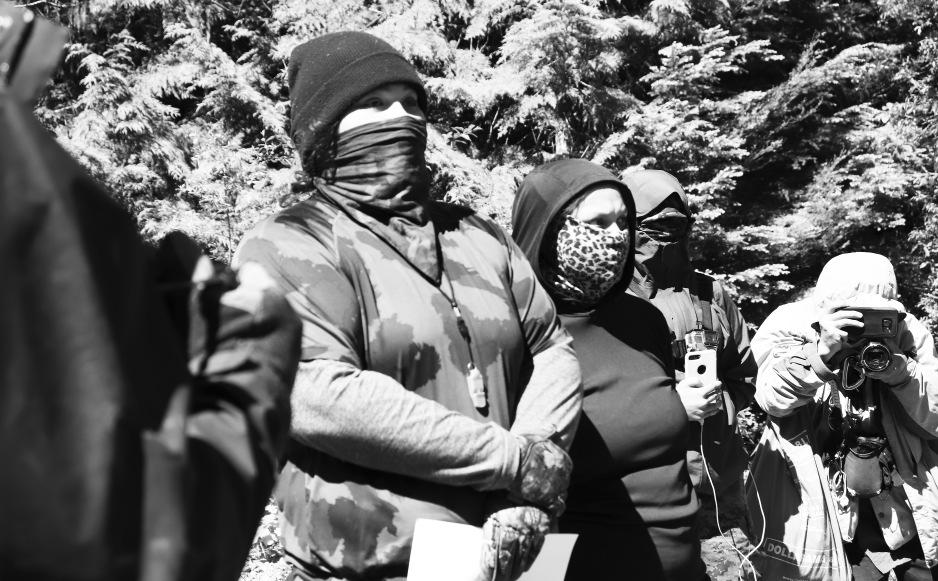
Photo by Denise Titian An eviction notice was read to protestors at a blockade by Carmanah Main on June 23 by Ditidaht Chief Councillor Brian Tate, with Tyee Ha’wilth Satiixub standing in support, along with Pacheedaht and Huu-ay-aht elected chiefs.
some of the activists took part in the Fairy Creek blockade. “The ones here this year were messy and disorganized,” said Tate. He said that the RCMP reported to him that they found several containers of fl ammable fl uids including gasoline. In a statement from C’awak %quin Forestry dated June 30th, the illegal encampment was built without free and prior consent of both hereditary and elected leaders of Ditidaht First Nation. “Yesterday’s enforcement comes following several unsuccessful, but peaceful, attempts by Ditidaht to have the illegal camp removed, including a meeting with elected and hereditary Indigenous leaders from the Ditidaht, Huu-ay-aht and Pacheedaht First Nations on June 23,” they wrote. By not obtaining consent from the First Nation for the camp, the activists violated both traditional Indigenous and provincial laws. “It also infringes on the legal decision-making authority and sovereignty of the three Nations within their Ḥaḥahuułi (Traditional Territories) and TFL 44, and the rights granted to Cawak ʔqin Forestry under provincial tenures and permits,” stated C’awak %quin Forestry. They went to say that interfering with the lawful use of property is a criminal off ense and impeding access to the forestry roads is a violation of the courtordered injunction granted by the courts regarding forest tenure in the area. Cawak ʔqin Forestry (Tsawak-qin Forestry Limited Partnership), formally known as TFL 44 Limited Partnership, operates TFL 44 and is a limited partnership between Huumiis Ventures Limited Partnership (wholly owned by Huu-ayaht First Nations) and Western Forest Products Inc. TFL 44 covers roughly 137,000 hectares of land on west central Vancouver Island in the vicinity of Alberni Inlet and Great Central Lake. Chief Tate says that everyone he’s spoken to in his community is happy that the encampment has been removed. Had it stayed, it would have the second year that his people were denied access to their yellow cedar bark, medicinal plants and hunting grounds. Tate recognizes that people have a right to peacefully protest but if they are thinking of demonstrating in Ditidaht territory in the future, they need to speak to the territory’s leaders fi rst, to ask for permission. “We may say yes, or maybe we’ll say no, but they have to come see us, we won’t be disrespected,” said Tate.
Hupačasath First Nation draws liquid maple gold
By Melissa Renwick Local Journalism Initiative Reporter
Port Alberni, BC - Hupačasath First Nation on Vancouver Island’s west coast is creating a unique fl avour of maple syrup using sap from bigleaf maple trees. As part of the Indigenous Bioeconomy Program, the nation is benefi tting from nearly $112,000 in funding from the province towards the business venture, named Kleekhoot Gold. The funding is designed to support Indigenous partners lead the development of a forest bioeconomy, according to the Ministry of Forests. “Bigleaf maple has always been used by Hupačasath for its wood, for smoking fi sh and game,” said Hupačasath First Nation Elected Chief Brandy Lauder. “Some of our members now also use the bigleaf maple syrup to glaze the fi sh and meat before smoking it with the maple wood.” Collecting syrup from bigleaf maple trees is a more complex production process, which makes the syrup up to four time more expensive than the price of standard maple syrup sold in supermarket, said Kleekhoot Gold. “To put the colossal size of the eastern sugar maple industry in perspective,” Kleekhoot Gold said around 17.4 million gallons of maple syrup was produced from sugar maples in eastern North America in 2019. Meanwhile, the combined bigleaf syrup production amounted to less than 500 gallons. The syrup is one of the rarest tree syrups available in today’s organic syrup market, according to Kleekhoot Gold. “Sap from west coast bigleaf maple trees is only one per cent sugar,” said Kleekhoot Gold. This means that 100 litres of sap might deliver one litre of syrup, Kleekhoot Gold added. The syrup has a distinct taste that can vary from notes of butterscotch and vanilla, to a more robust molasses fl avor near the end of season. Named after one of the nation’s ancestral village sites, Kleekhoot is home to an abundance of bigleaf maple trees that are unique to B.C.’s west coast. Located on the “confl uences of the Sproat and Stamp rivers”, Lauder said the village site was inhabited by one of the original tribes of Hupačasath Kleekhootaht, and continues to be occupied today. Lauder said Kleekhoot Gold has provided employment opportunities for youth and brought the nation’s members back into the forests with a “renewed sense that there is more to the forest than just logging opportunities.” Hupačasath values developing businesses that “contribute to a forest bioeconomy by making use of untapped natural resources in a sustainable way that protects forests and creates jobs,” said Kleekhoot Gold. “Riparian areas, such a rivers and streams, are usually off limits to logging operations,” the company added. “Conveniently, these areas are where maple trees grow best. The winter harvest of maple sap allows for unique job opportunities in the months that traditionally have less seasonal work available.” Since it was launched in 2015, Hupačasath has invested over $300,000 into the business to bring the product to market. The syrop is sold at the Hupačasath’s band offi ce, as well as select local events. Josie Osborne, MLA for Mid IslandPacifi c Rim, recently visited the production facility and said Kleekhoot Gold “is a great example of how innovative forest management can help strengthen communities.” “People in the Alberni Valley take so much pride in locally grown food, and bigleaf maple syrup makes a sweet addition to our local food landscape,” she said in a release. Since 2019, the Indigenous Forest Bioeconomy Program has delivered 41 projects in partnership with 24 Indigenous communities and organizations across the province. These include essential oils being extracted from conifer needles and textiles made from bark. Around $1,126,000 was used to fund the program in 2021 and 2022, and an additional $3.9 million is being contributed this year to move projects to commercialization faster, according to the ministry. “By locally producing maple syrup from the abundance of bigleaf maple trees unique to the west coast of British Columbia, the Hupačasath First Nation is showing us how we can all benefi t from our forests in new and sustainable ways,” said Doug Routley, parliamentary secretary for forests.
Two-month presentation of evidence shows a ‘discrepancy of resources’ between First Nation and the province
By Eric Plummer Ha-Shilth-Sa Editor
The trial over the Nuchatlaht’s claim of Aboriginal title to the northern part of Nootka Island is currently on a summer break, as the First Nation’s legal team and the province’s lawyers prepare their fi nal arguments. Over 40 days in court that began March 21, the evidence portion of the trial ended May 26. Both sides are now reviewing facts presented to Justice Elliot Myers over the two months, assembling their fi nal arguments for the B.C. Supreme Court. Owen Stewart from the Nuchatlaht’s legal team is confi dent in how things have progressed so far. “I think the trial went very well for us,” he said. Originally fi led to the court at the beginning of 2017, the Aboriginal title case entails the Nuchatlaht seeking legal recognition - under B.C. and Canadian law – of 20,000 hectares of territory across the northern part of Nootka Island, which is located west of Vancouver Island’s north. The case is considered an important milestone in how British Columbia considers an Indigenous community’s ownership over traditional territory, and a decision on the small First Nation’s claim could pave the way for others seeking legal recognition. The Nuchatlaht case relies heavily on a decision upheld by the Supreme Court of Canada in 2014, in which the Tsilhqot’in were granted Aboriginal title over 1,700 square kilometres in central B.C. – despite being considered a “semi-nomadic” group of tribes. The Tsilhqot’in case was in court for almost 400 days, making it one of the most expensive trials in B.C. history. But with the precedent set, the Nuchatlaht case has so far lasted a fraction of the time. “Everybody knows that Aboriginal title litigation is incredibly expensive,” said Stewart. “We made a number of tactical decisions to try and make the trial as thorough as possible in as least amount of time as possible.” The Tsilhqot’in decision determined that Aboriginal title requires a nation’s proof of exclusively and continually occupying an area before the British Crown asserted sovereignty. In the Nuchatlaht’s case, the legal test is proving occupation of Nootka Island back to 1846, a time when the First Nation’s legal team presented the existence of a confederacy of at least half a dozen tribes with a governance structure in place. Thanks to extensive records from Brit-
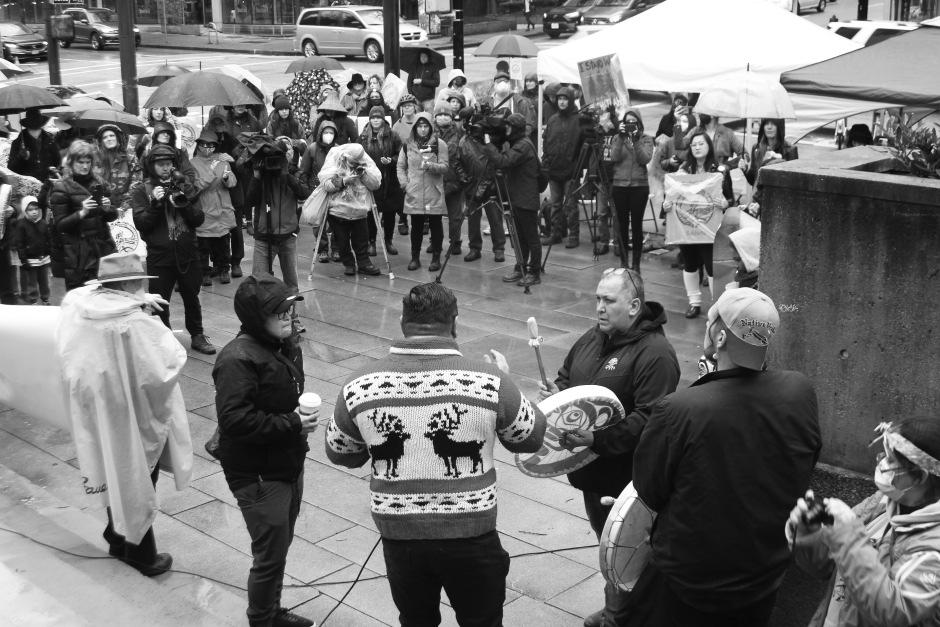
Photo by Eric Plummer Nuchatlaht supporters drum in front of the B.C. Supreme Court on March 21, the fi rst day of the First Nation’s trial over its Aboriginal title to northern Nootka Island. ish Columbia’s fur trading era, the First Nation’s legal team was able to trace a genealogical line from the current Tyee Ha’wilth Jordan Michael to Chief Tarrason, who led the Nuchatlaht in the late 1700s. But the province has disputed the assertion that the Nuchatlaht are the only First Nation to own and occupy the territory for the last century and a half. “The modern-day Nuchatlaht does not presumptively gain Aboriginal title from other local groups,” said Jeff Echols from the provincial government’s legal team during opening arguments in March. “You can’t say that the groups in 1846, or the date of sovereignty, were necessarily Nuchatlaht.” “It’s something that the province is continuing to push,” commented Stewart. In proving continued occupation of the claim area, both sides relied heavily on archaeological studies. For the Nuchatlaht this included hundreds of pages from expert witness Jacob Earnshaw that detailed the presence of culturally modifi ed trees throughout northern Nootka Island. But the province also provided expert witnesses, including three who were contracted just to dispute an archaeologist who was going to testify for the Nuchatlaht. “We dropped one of our expert witnesses, Chelsea Armstrong, because the province had called three witnesses to respond to her one report, which could have added another at least two weeks, maybe four weeks to the trial,” said Stewart, noting that the provincial government’s approach was to dispute everything that the First Nation’s team presented. “I think the province’s plan was to challenge the line that we draw on a map, and say ‘This line isn’t accurate’.” This approach indicated a “discrepancy of resources” between the two sides, said Stewart. With less than 170 registered members, the case has already cost the Nuchatlaht considerably, making additional weeks a concerning drain on the First Nation’s fi nances. Two thirds of the trial have so far been taken up by the provincial government’s presentations. “The province has these resources to ask everyone and everything to write an expert report,” added Stewart. Northern Nootka Island is currently Crown land, managed through a forestry tenure held by Western Forest Products. The forestry company was originally a defendant in the case, but after the fi rst week of the trial WFP stepped out when it was determined its participation was no longer relevant. During its opening argument in March Western questioned how forestry obligations, such as replanting and de-commissioning logging roads, will be met if the Nuchatlaht gain legal ownership of the land. “The spectre that they raised isn’t an issue for this trial,” said Stewart, adding that it was found that the province can designate other areas in the region for WFP to log. “They would be able to access other areas of Crown timber, so it wouldn’t impact their annual allowable cut.” The trial is scheduled to be back in court Sept. 26 for fi nal arguments to be presented. This is expected to last three weeks in Vancouver. Les Sam Construction

Residential . Commercial & Architectural Structures Construction Management & Consulting Forming & Framing Ph/Txt: 250.720.7334 les sam@shaw.ca
Have You Moved?
If you should be getting a copy of the Ha-Shilth-Sa paper delivered to your home, please contact: Holly Stocking at 250-724-5757 or holly.stocking@nuuchahnulth.org
Opitsaht, BC - As Eddie Frank travelled to Opitsaht from Tofi no in a water taxi, he openly spoke over the phone sharing his excitement about witnessing the raising of a totem pole for the fi rst time. The 71-year-old had seen it done in videos before, but never in person – and never in Nuu-chah-nulth territory. “It means a lot to me,” he said. “I don’t see too many totem poles on the west coast.” Around two years ago, Tla-o-qui-aht First Nation master carver Joe Martin was asked to carve a totem pole by his brother, Nookmis. As the head of their family’s house of Ewos, Nookmis wanted it to be carved in remembrance of “the pandemic we all faced together,” Martin said. With the help of various local artists, including his daughter, Gisele, Gordon Dick, Patrick Amos, Robin Rorick, Ken Easton, Robinson Cook and Nookmis, Martin began carving the totem pole on June 18, 2021. Over a year later, it was transported from the Naa’Waya’Sum Coastal Indigenous Gardens (formerly the Tofi no Botanical Gardens) in Tofi no, to Tla-o-qui-aht’s ancient village site on Meares Island in preparation for its raising on July 1. It was not a small task and required a truck, barge, crane and the strength of around 40 people to move the 32-foot-tall totem pole to its rightful place. Dick described it as another step in bringing it to life. “It’s exciting to see all the support that’s pulling the community together,” he said. Before European settlers arrived on the west coast in the late-1700s, most families
“It’s exciting to see all the support that’s pulling the community together” On Canada Day, a new totem pole is raised in Opitsaht
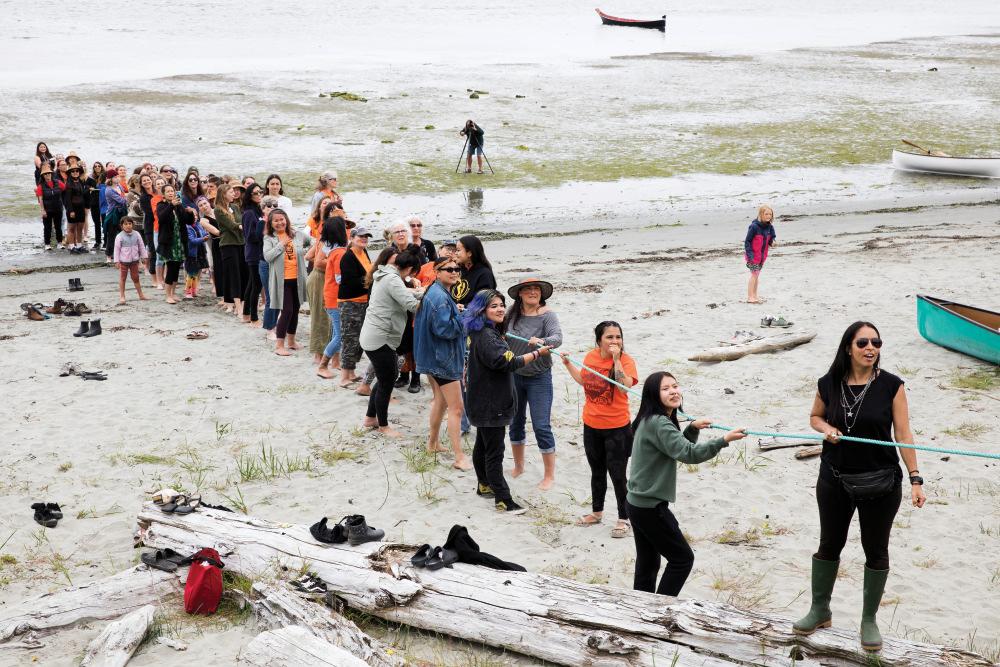
The middle rope was pulled by a long line of women, in Opitsaht on Meares Island, on July 1.
Photos by Melissa Renwick
~ Gordon Dick
from Tla-o-qui-aht had four totem poles displayed in front of their homes. When a woman married into a tribe, a totem pole was raised to depict her family’s history. It would stand next to three others: one for her husband’s history, another for his parent’s history and the fourth for his grandparent’s history, according to teachings given to Martin by his late-father. In 1792, American trader Captain Robert Gray set fi re to around 200 homes in Opitsaht, along with all the totem poles that stood beside them. Around a century later, many of the totem poles that had been replaced were removed from Opitsaht when the Indian Act was passed by the federal government in 1876. The act aimed to eliminate Indigenous culture, with the goal of assimilating First Nations, Inuit, and Métis into a Eurocentric society, and provided a framework for government offi cials and ethnologists to remove totem poles. Some of the only remaining relics carved in the traditional Tla-o-qui-aht style can be found at the Field Museum of Natural History in Chicago. Up until now, only two totem poles from 1989 and 1993 remained in Opitsaht – both of which have succumbed to the harsh west coast elements and have begun to rot. Martin had his hand in carving both of them, which were raised by his father and stand in front of the land of his childhood home. When the new pole was transferred from Tofi no to Opitsaht on June 29, it was placed in between the two existing structures. Named after one of Martin’s ancient relatives who was a “truth-speaking orator,” the new totem pole is called Hinaaqsuuqʷa. Around 100 people poured onto Meares Island on July 1 to witness the raising of Hinaaqsuuqʷa. Using three ropes tied around the front and one secured to the back, Martin directed those gathered to help push and pull the totem pole upright. Once raised, men raced to shovel and pack soil into the hole where the totem stood to secure it into place. Overwhelmed with emotion, Nookmis said he didn’t have the words to describe how he felt. In many ways, he said, the totem pole was carrying on his father’s legacy. Since the artists began carving Hinaaqsuuqʷa, it has garnered a lot of public attention and was even featured in the latest issue of National Geographic Magazine. By carving the totem pole in a public space at the Naa’Waya’Sum Coastal Indigenous Gardens, Martin said people were able to drop by and ask questions.
